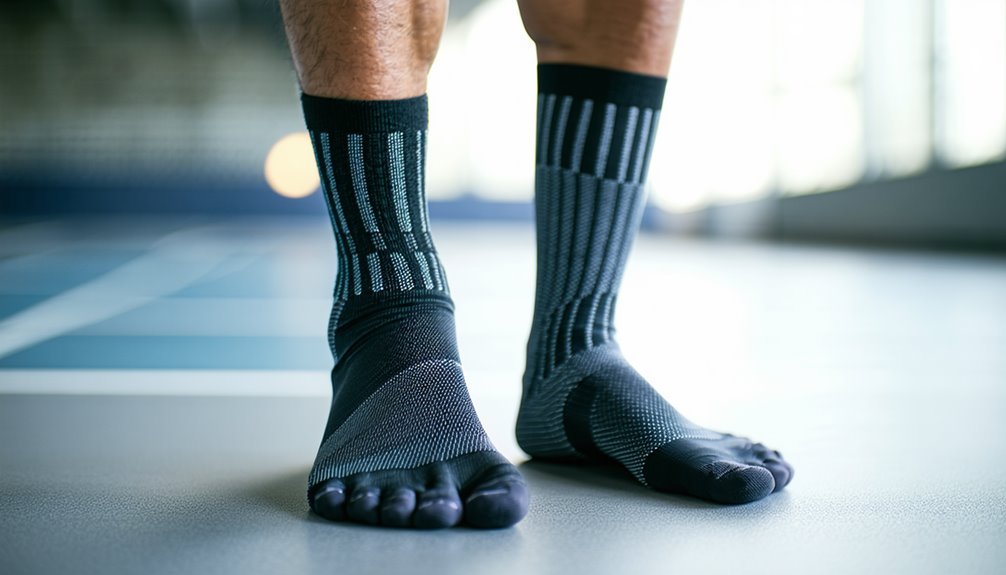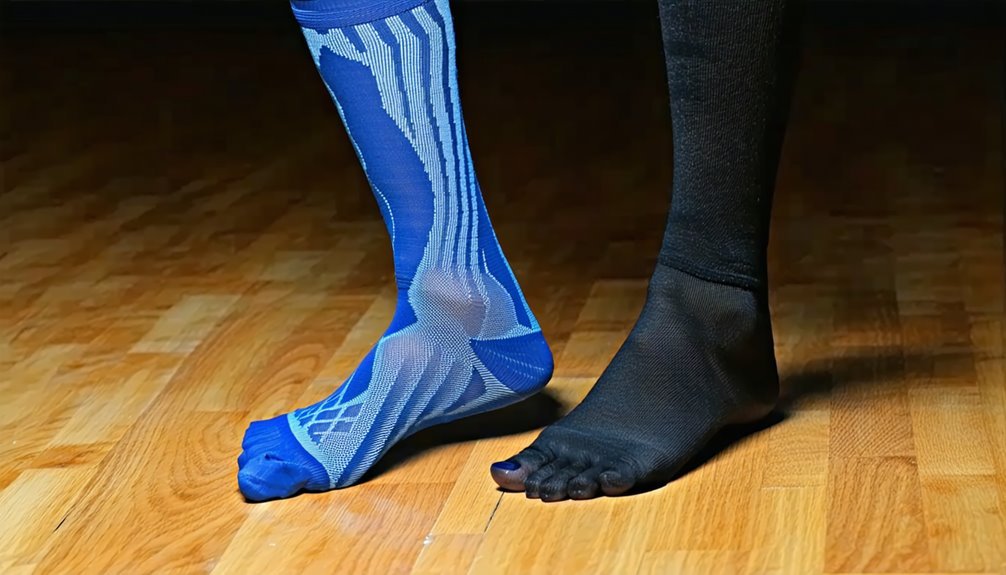Compression Sock Vs Sleeve
When considering compression sock vs. sleeve, it's essential to understand their distinct benefits. Compression socks cover the foot and knee, enhancing venous return and reducing swelling, ideal for long periods of standing or sitting. Compression sleeves focus on the calf, supporting muscle recovery and minimizing fatigue, beneficial for athletes. Materials and compression levels affect comfort and therapeutic outcomes. Each serves specific needs, and exploring further can help you make the right choice.
Understanding Compression Technology

Compression technology, while seemingly straightforward, involves intricate biomechanical processes that enhance blood circulation and reduce muscle fatigue. You'll find that the effectiveness of compression socks and sleeves is rooted in their ability to apply precise compression levels to specific areas of the lower limbs. This pressure gradient supports venous return, mitigating the risk of blood pooling and potential clot formation.
With technology advancements, materials have evolved to offer graduated compression, guaranteeing ideal pressure distribution. These developments are grounded in anatomical research, assuring the safety and efficacy of these garments. When selecting compression products, it's vital to take into account the appropriate compression levels for your needs. This guarantees both comfort and the prevention of adverse effects, making these garments a reliable choice for enhancing circulatory health.
Benefits of Compression Socks
When you wear compression socks, they can greatly enhance blood circulation by applying graduated pressure to the lower extremities, which helps in promoting venous return. This improved circulation not only minimizes the risk of swelling, particularly in individuals with prolonged standing or sitting periods, but also has the potential to boost athletic performance by optimizing muscle oxygenation. Evidence-based studies suggest that these physiological benefits can be instrumental in both medical and athletic contexts.
Improved Blood Circulation
Although often overlooked, enhancing blood circulation is a vital benefit of wearing compression socks. These garments apply graduated pressure to your lower legs, promoting venous health by facilitating blood flow back to the heart. Enhanced blood flow reduces the risk of blood pooling in the veins, which is important for preventing conditions like deep vein thrombosis. The clinical evidence supports their use for improved circulatory efficiency.
| Compression Level | Pressure (mmHg) | Purpose |
|---|---|---|
| Mild | 15-20 | Daily wear, improved circulation |
| Moderate | 20-30 | Varicose veins, moderate venous issues |
| Firm | 30-40 | Severe venous conditions |
| Extra Firm | 40-50 | Lymphedema, severe venous insufficiency |
Choosing the appropriate compression level is essential for safety and effectiveness, ensuring that your venous health is adequately supported.
Reduced Swelling Risks
Swelling, particularly in the lower extremities, can be effectively managed through the use of compression socks. These socks apply graduated pressure, aiding in swelling prevention by promoting efficient fluid management. Here's how they work:
- Venous Return Enhancement: Compression socks boost blood flow back to the heart, reducing fluid accumulation in your legs.
- Interstitial Fluid Displacement: The applied pressure helps move excess fluid from tissues back into the circulatory system, decreasing edema.
- Lymphatic Drainage Support: By stimulating lymphatic function, these socks prevent lymph fluid buildup, reducing swelling risks.
Clinical studies support their effectiveness, showing that consistent use of compression socks can markedly lower the incidence of swelling. If you're concerned about fluid retention and seek a reliable solution, these socks offer a proven, safe method to manage it.
Enhanced Athletic Performance
While athletes constantly seek ways to optimize their performance, the use of compression socks has emerged as an evidence-based strategy worth considering. These socks apply graduated pressure to the lower extremities, promoting efficient venous return and reducing muscle oscillation during activity. By enhancing blood flow, they can potentially improve oxygen delivery to muscles, which is essential for performance enhancement and increased athletic endurance.
Research supports that compression socks may help you sustain peak performance for longer periods by minimizing muscle fatigue and soreness. The enhanced circulation may also expedite recovery post-exercise, reducing the risk of injury. For those concerned about safety, rest assured that when used correctly, compression socks are a well-tolerated tool that can complement your athletic regimen effectively.
Advantages of Compression Sleeves
When considering the advantages of compression sleeves, it's essential to highlight their anatomical benefits. They're designed to support specific muscle groups, providing targeted compression that aids in injury prevention. Here are three key benefits:
- Enhanced Circulation: Compression sleeves improve blood flow, ensuring oxygen-rich blood reaches your muscles efficiently. This can reduce muscle fatigue and promote quicker recovery.
- Muscle Stabilization: By securely wrapping around your muscles, sleeves minimize vibrations during activity. This reduces the risk of strains and sprains, contributing to injury prevention.
- Temperature Regulation: Lightweight, breathable materials help maintain ideal muscle temperature, reducing the risk of overheating or cramping.
Incorporating these compression sleeve benefits into your routine can enhance safety and performance, allowing you to focus on your activities with confidence.
Considerations for Choosing the Right Option
When selecting between compression socks and sleeves, you'll need to take into account their specific purpose and functionality, as each option targets different anatomical needs. Evaluate the material and comfort level since these factors greatly impact your compliance and overall experience. Finally, match your choice to the type of activity and expected duration to guarantee ideal vascular support and muscle recovery.
Purpose and Functionality
Understanding the purpose and functionality of compression socks versus sleeves is essential for making an informed choice. Both are designed to enhance circulation and support specific body parts, but their design differences and target areas vary.
- Compression Socks: These cover the foot and extend up to the knee. They're ideal for reducing swelling in the feet and enhancing venous return from the lower extremities, which is beneficial for those with varicose veins or who stand for long periods.
- Compression Sleeves: These focus on the calf area, providing targeted support without covering the foot. They're suitable for athletes seeking improved muscle recovery and reduced fatigue.
- Selection Criteria: Consider your specific needs, whether it's thorough support or focused relief, to guarantee best safety and effectiveness.
Material and Comfort
Selecting the right material for compression socks or sleeves is essential for ensuring ideal comfort and performance. Different fabric types, like nylon, spandex, and cotton blends, offer varying degrees of elasticity and breathability, directly impacting comfort levels. Nylon and spandex provide a snug fit, enhancing compression and support. Meanwhile, cotton blends can offer better moisture management, reducing friction and skin irritation. Your skin's response to different materials should guide your choice, ensuring safety and preventing allergic reactions.
Moreover, consider the anatomical design. Graduated compression, where pressure decreases from ankle to calf, is often recommended for best circulation. Evidence-based research indicates that such designs promote venous return and reduce fatigue. As a result, selecting the appropriate fabric type is pivotal in achieving the desired comfort and therapeutic benefits.
Activity and Duration
Although personal preference plays a role, tailoring your choice of compression gear to your specific activity and its duration can greatly enhance effectiveness. To guarantee ideal support and safety, consider the following:
- Running Intensity: High-intensity runs can benefit from full compression socks, as they offer enhanced circulation and muscle stability, reducing fatigue.
- Duration of Activity: For shorter activities, compression sleeves might suffice by focusing on calf support without the need for complete foot coverage.
- Recovery Time: Post-activity, full compression socks can aid in quicker recovery by promoting blood flow and reducing swelling, which is essential after prolonged exertion.
Comparing Use Cases and Scenarios
When deciding between compression socks and sleeves, it's vital to take into account their specific use cases and scenarios. Compression socks are ideal for prolonged standing or sitting due to their full coverage, providing consistent compression from foot to knee. They're often recommended for individuals with venous insufficiency or during long flights. Conversely, compression sleeves offer flexibility, targeting only calves, which suits athletes seeking muscle support during high-intensity activities. Your activity preferences play a significant role; if you're a runner, sleeves might enhance performance and recovery without restricting foot movement. Both options improve circulation and reduce swelling, but understanding anatomical needs guarantees safety and effectiveness. Make informed choices based on your use case scenarios to maximize benefits.
Tips for Proper Use and Maintenance
To guarantee ideal results from your compression gear, it's crucial to adhere to proper use and maintenance guidelines. First, verify proper storage by keeping your compression socks and sleeves in a cool, dry place. This prevents material degradation and maintains elasticity. Second, follow evidence-based washing techniques: hand wash with mild detergent and air dry to preserve the fabric's integrity and compression strength. Avoid using bleach or fabric softeners as they can compromise the garment's effectiveness. Third, verify correct sizing and fit, as improper fit can reduce therapeutic benefits and affect circulation. Regularly inspect your gear for wear and tear, replacing it as needed. By following these steps, you'll verify your compression gear provides maximum support and safety.
Frequently Asked Questions
Can Compression Socks or Sleeves Help With Travel-Related Swelling?
You're wondering if these can aid in travel comfort and swelling prevention. Clinically, their graduated compression supports venous return, reducing leg swelling. Evidence shows they improve circulation, enhancing safety during long journeys by minimizing clot risks.
Are Compression Socks or Sleeves Suitable for Children?
Children's comfort is essential, and pediatric recommendations suggest careful use. Ascertain the compression level is appropriate and consult a healthcare provider. Anatomical differences in children require evidence-based choices to prioritize safety and effective circulation support.
How Do Compression Levels Differ Between Socks and Sleeves?
Imagine tightness hugging your calf versus gently gripping your arch. Compression levels vary, with socks offering graduated support from ankle to knee, enhancing circulation. Sleeves focus on calves, providing moderate compression. Sock benefits include extensive support, boosting safety.
Can I Wear Compression Socks or Sleeves Overnight?
You're considering wearing compression garments overnight. The benefits overnight include improved circulation and reduced swelling. However, potential risks involve skin irritation and restricted blood flow. Consult a healthcare professional to guarantee safety and assess your specific needs.
Are There Any Fashion-Forward Options for Compression Socks or Sleeves?
You're in luck! There are trendy designs and stylish patterns available. These options provide the same anatomical support and evidence-based benefits while ensuring you don't sacrifice style for safety and clinical effectiveness. You'll look and feel great!







